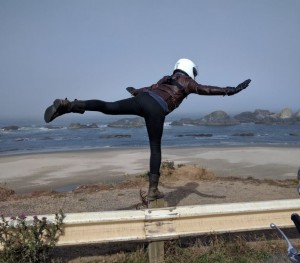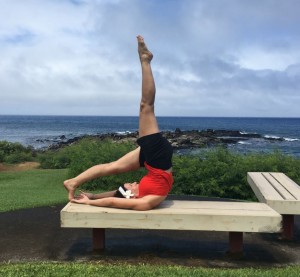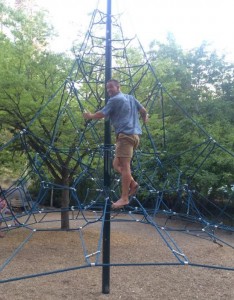Christine Crooks-Nguyen & Tony Nguyen / Nephesh Pilates & TwoPoint4 Dance Theater
Moving It All Outdoors
James Crader
For a moment, close your eyes and think of a few iconic Pilates movement moments involving Joe, the man. Images of a studio may come up, but undoubtedly, for many of us, thoughts of Jacob’s Pillow surfaced, or possibly Joe in playful combat or crawling around on grass. When was the last time you took your practice (or better yet play) outdoors? I’m a lover of linguistics and a student of communication, and Joe Pilates has some badass quotes such as, “Normal muscles should function naturally in much the same manner as do the muscles of animals.” Never one to mince words, I really doubt he meant that we study Pilates indoors so we can get better at doing Pilates on machines! Animals are too busy wilding to have a need for exercise. I’ve always taken his words as instruction to explore and strengthen movement potential through the method, then go do something naturally fun with what I’ve learned. Plus, there are so many benefits to our great outdoors (and backyards for that matter).
Let’s talk about sunshine. Hot topic, right (puns!)? Seriously though, no natural element has had worse PR in our time than sunshine. We’re all smart adults here, so make your best decision about your relationship with the sun for your skin type, genetics, and latitude. Be more mindful of the sun at its peak intensity, which is generally solar noon to late afternoon. However, beyond that, it might be a good idea to spend some time with your old friend – sunshine. Safe sun exposure is the best way to generate and bio-accumulate Vitamin D.
But what’s so important about this Vitamin D?
Well, quite a lot: it fights depression; stimulates the immune system; combats MS, flu, and heart disease; promotes strong bones, healthy youthful skin, and muscle function; and boosts weight loss. The light generated by the sun includes 1,500 different wavelengths, but only the Ultraviolet-B (UVB) wavelength will produce Vitamin D when it hits the skin. I know someone out there is thinking GREAT! I have so much natural light in my studio! Unfortunately, most glass blocks out the UVB rays. So try as you might to invite it inside, Vitamin D lives outdoors.

Dan Rogers / The Pilates Twist
No problem, I’ll slather on some sunscreen and do my Hundred in the garden.
For the sake of space, we’ll just ignore the toxic litany of sunscreen ingredients (that then absorb directly into your blood), and instead focus on the fact that many sunscreens, like glass, reflect UVB rays but allow Ultraviolet-A (UVA) rays to pass through. UVA rays are the sun’s wavelengths that increase your risk of cancer and cause photo-aging. The body’s natural defense against sunburn, and UVA overexposure, is that slight “pinking” of the skin that comes from UVB exposure. Without UVB exposure, we often don’t know when to get out of the sun before it’s too late. There are many natural and essential oils that can assist in a good relationship with the sun, and they are but a Google search away if you are interested in learning more.
Okay, I’ll buy your sun argument, but it’s just too cold outside.
Again, use your judgment as to when is too cold to play outdoors. But remember Joe was known to walk about town in the snow without much in the way of “extra layers.”

Chantill Lopez / Skillful Teaching
Maybe that dude was really on to something?
Here’s what science is telling us about being cold. Inside of each of us we have both white fat (the kinda’ fat that we all know and love?), and we also have brown fat. Yup, brown fat. Brown fat is activated by even moderately cool temperatures. For energy, this fat burns calories much more efficiently than white fat, and stimulates our lymphatic system – you know, that underappreciated system that pretty much keeps us healthy. Think of it this way, brown fat is healthy fat. Here’s the really cool thing, our body can convert its white fat into brown fat! Here’s how: by feeling cold.
That’s it?
Yup! You’ll literally become skinnier and healthier by feeling cold. Suddenly an early morning “Pilates in the park” session (or an evening stroll sans jacket) sounds more appealing.
Beyond just being prettier than any studio you’ll go into, the outdoors has so many other movement benefits. We don’t often consider our eyes as muscular. But … they are. We have ciliary muscles around each eye that adjust our eye’s lenses to distances. They work sort of like a shutter on a camera. When you look at distant objects, these muscles have to soften and relax. We spend an awful lot of time looking at things up close (TV / phones / books / our
client’s weird shoulder), and far less time gazing into the distance. As a result, our eye muscles can becomechronically tight (like those shoulder muscles on the client that sits at her high stress job all day).

Audrey Langstroth / Nephesh Pilates
Well how do I work with that?
Just go outside and gaze around. Look at that tree far away. Are there any birds in it? Just being outside has tremendous positive effects on our whole system. There’s been research done on walking through the woods and its effect on the nervous system. They’ve found that just by being in the outdoors, our nervous system automatically provides a parasympathetic calming response.
How?
Mostly it’s due to something called “involuntary focus.” In a quiet, outdoor space, our mind has the opportunity to wander, but be gently engaged with the subtlety of its environment.
OK, so what now?
I’m as impressed by newly renovated, architecturally interesting studios as the next guy, but I have a hunch that if Joe came back today, he’d say we’ve made the studio environment just too comfortable. It is climate controlled, you work on a cushioned reformer (with maybe a head pillow, or support here or there), there’s some small talk about the new restaurant you found (maybe that’s just my studio), blah blah blah, end of session. Certainly many cases call for more care here or there, but how might moving outdoors enrich your Pilates? Maybe the session was easy, maybe it was leg-trembling hard, but was it whole body intriguing? Even our most challenging exercises could become more if they were experienced in an unpredictable and constantly changing natural environment. Good movement is about learning to adapt to any environment. That begs the question of why are you even doing Pilates at all? If your goal is to master Snake and Twist on the Reformer, then the studio environment is the spot to do that! If your goal to master the “suppleness, natural grace, and skill that will be unmistakably reflected in the way you walk, [and] the way you play,” then follow Joe’s quote and example, and explore the wild you outdoors, whether it be in mat work, parkour, play, or just a simple walk with your dog (barefoot?)

James Crader is a Movement Practitioner specializing in Pilates and John F. Barnes Myofascial Release Therapy, a CoreAlign Faculty Member, and owner of Evolved Body in Sacramento, CA. His work with athletes was recently featured in Mark Pedri’s Pilates documentary A Movement of Movement. Originally trained through Balanced Body, James has since gone on to study with numerous instructors both Contemporary and Classical including a mentorship program with Pilates Elder, Lolita San Miguel. James feels privileged to have been asked to teach workshops nationally, and internationally in Joseph Pilates hometown of Monchengladbach. His passion is to assist people in exploring how their bodies can move and feel better, from a re-conditioning environment to athletic performance training. Catch his website here.

